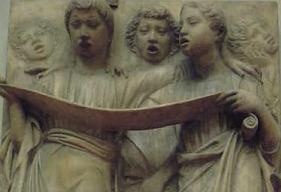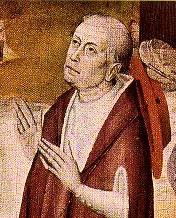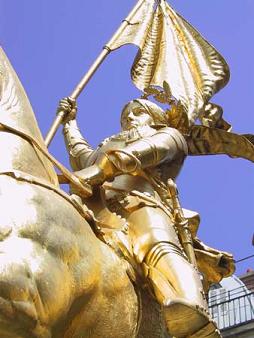THE EMERGENCE OF THE GOLDEN RENAISSANCE
Two seemingly unrelated events profoundly impacted the course of history in 1240 AD. One was the Venetian-led conquest of Ferrara, the Italian city which commanded the great commercial route into the plains of Padua, and hence, to all of Europe. The other was the nearly complete destruction of Kiev, the principal trading center of Russia, by Venice’s murderous ally, Mongolia. With Italy on her knees, and the Mongolian Empire near its height, Venice, with scant competition from Genoa, commanded perhaps the greatest financial and trading empire the world had ever seen. Key to all of this was Venetian control of the bullion trade. With European silver, Venetian merchant squadrons purchased gold and slaves from the Mongols. Slaves and silver were then sold in North Africa and the Levant, for more gold. The squadrons returned to sell the gold for a new load of silver, and so on. Each transaction netted wild profits, and rapidly placed the entire known world on a usurious, Venetian-controlled monetary system. Venice became the world’s mint, as well as the world’s banker, and proceeded to loot the world’s economy in every way imaginable. The fact that Venetian merchants also controlled the bulk of European trade in hard commodities such as wool, silk, and spices, was incidental.
Webster’s dictionary defines usury as "the practice of lending money at an exorbitant interest rate," but that is not nearly adequate to describe the depredations of Venice. In 1337, for instance, Venetian-controlled bankers lent Edward III of England a relatively small sum to finance an ill-advised invasion of France, which opened the famous Hundred Years War. The loan was secured on the expected revenue from a tax on wool production in England. When wool production in England fell sharply as a result of persistent looting of the wool producers, Edward was forced to default on his loan payments. As a result, by 1345, the financial system of Europe simply disintegrated. No longer could a gigantic financial bubble created by Venice be sustained. The physical economy had been looted to the point where a vast chain of usurious financial obligations could no longer be met. As a result, nearly one-half of the population of Europe perished in the ensuing Black Death, which was made possible only by decades of Venetian-led destruction of the physical economy. The capacity of the population to defend itself from such a calamity was gone. As if divine retribution were at work, nearly three-fifths of the inhabitants of Venice also perished, including a large number of the mercantile authors of this catastrophe.
Fortunately, the human spirit emerged from the Black Death with a new determination to be free. Led by Petrarch, the newfound Conciliar Movement, which sought to reunite a deeply divided Christendom around the Augustinian notion of the Filioque, began to create the conditions for the Renaissance by launching an earnest effort to break the straitjacket of Aristotelian scholasticism that had gripped Europe throughout. As a first step toward this goal, Conciliar movement activists were sent to the Greek world to recover the manuscripts of Plato, Aeschylus, Archimedes, and numerous other classical authors, which were then translated into Latin.
In the wake of the Conciliar movement, a group of northern European humanists led by Gerhard Groote founded a teaching order called the Brotherhood of the Common Life, which rapidly spread throughout Holland, Germany, and France. The Brotherhood taught primarily poor children, and focussed much of its activity on copying the newly acquired classical manuscripts, thereby encouraging new learning. One of the early students of the Brotherhood was Nicholas of Cusa, who, as we will see, became a seminal figure of the Golden Renaissance.

In the 1420’s, a monk named Ambrogio Traversari began to gather in his cell near Florence, Italy, a group of Conciliar Movement activists and humanists including such notables as Niccolo Niccoli, Paolo dal Pozzo Toscanelli, and Aeneus Sylvanus Piccolomini, who later became Pope Pius II. Perhaps every important figure in the Italian Renaissance was in some way connected to these circles. For example, Toscannelli was the mathematics instructor of Fillipo Brunelleschi, the architect of the Dome of Florence and the founder of modern architecture. Brunelleschi, in turn, instructed Lucca della Robbia, the sculptor of the famous bel canto singers in the relief of the Florence Cathedral cantoria. Later, a young man by the name of Leonardo da Vinci became a good friend Toscanelli.
Among the topics of great interest in Traversari’s cell was geography, particulary with respect to the desire of Florence to break the grip of Venice on maritime trade. Toscanelli, and others, pored over a recently acquired manuscript of Ptolemy’s Geography in an attempt to find a new sea-route to the East, outside the control of Venice. Though Ptolemy’s work included the hoax that Africa could not be circumnavigated because it is surrounded the Indian Ocean, Toscanelli persisted. Later, he produced the map that Christopher Columbus used on his voyage of discovery. Columbus copied this map on the frontispiece to his most treasured book, a copy of Universal History of Facts and Deeds, by Aeneus Sylvanus Piccolomini.

In 1432, Nicholas of Cusa was sent by the Church to the Council of Basel, which was organized by the Conciliar Movement. As was said above, Cusa received some of his early education from the Brotherhood of the Common Life. After earning his Bachelor’s degree at the University of Heidelberg, he went to Padua, where he studied canon law, and met his life-long friend and collaborator, Paolo dal Pozzo Toscanelli. Cusa then returned to Germany to study philosophy and theology at the University of Cologne, in order to become a priest. At the Council of Basel, Cusa submitted his groundbreaking work, The Catholic Concordance. The revolutionary thesis of this work was the idea that since all men are created equal in the image of God, and endowed by God with reason, legitimate and peaceful government can only come from the consent of the people, and not from any coercive law. In spite of Cusa’s intervention, the Council of Basel failed to unify the church. However, one of the attendees of the Council was Ambrogio Traversari, who was sent by Pope Eugene IV. Cusa collaborated with Traversari, and soon became a papal envoy to Constantinople, with instructions to organize a more comprehensive Council including representatives of the schismatic Orthodox Church of the East. Cusa spent several months organizing in Constantinople, and eventually recruited 700 Greek representatives, including Emperor John VIII Paleologue, and Joseph II, the patriarch of the Orthodox Church.
The Council convened in Ferrara in 1438, but was soon moved to Florence in order to flee a fresh outbreak of the plague. In Florence, the Council proceeded under extremely adverse circumstances. On several occasions it was nearly disbanded for lack of funds. Florence, meanwhile, was at war with Milan. In any event, the delegates found themselves surrounded with architecture and artwork of incomparable beauty. Most of the sessions, for example, were held in the Santa Maria Novella, where Massacio, a protégé of Brunelleschi, had painted one of his great masterpieces, a life-size fresco of the Trinity, which beautifully demonstrated the new science of perspective.
The main topic of discussion at the Council of Florence was the reunification of the Church around the Filioque, which asserts that the Holy Spirit proceeds from both the Father and the Son. The Filioque had been a Western addition to the Nicene Creed, which the Orthodox Church, under the influence of the Arian heresy, had chosen to reject. The implications of the Filioque are simple: If the Holy Spirit proceeds from the Father and the Son, then the Father and the Son are equal. If the Son is equal to the Father, then, by virtue of His human nature, man is united with God, in the Son. Hence, there is an unbroken relationship between God and man. Man, therefore, is not a mere beast, but rather, wholly participates in the divine essence. Such a concept is clearly antithetical to the system of political economy promoted by Venice, which degraded the majority of human beings to the status of slaves, serfs, or worse.
The Council of Florence, however, was much more than a theological debate. It was also an opportunity for many of the world’s greatest scholars to meet and discuss a range of topics. One of the Greek emissaries, for instance, was the great, neo-Platonic scholar, Gemistos Plethon, who had written important treatises expounding every principal feature of modern, capitalist economy, for both industrial and agricultural growth. Cusa brought Plethon’s writings with him, as well as manuscript of Plato’s Parmenides, which touched off a lively debate. During the Council of Florence, Plethon gave a series of lectures on Strabo, a 1st century, Hellenistic geographer, whose work refuted Ptolemy. With the geographical encyclopedia of Strabo, which was presented to the Council by Plethon, Toscanelli was able to revolutionize his own investigation of geography, and produce the map that guided the later voyages of Columbus. The Council concluded with a passionate speech by Plethon on the antithesis between Plato and Aristotle, which inspired the founding of the Platonic Academy of Florence. Finally, on July 6, 1439, a Decree of Union between the Catholic and Orthodox Church was announced, fittingly, under Brunelleschi’s newly completed dome over the Santa Maria del Fiore. In sum, what emerged from the Council of Florence was a community of principal, based on the Filioque, for the cultural and economic development of man.
The oligarchs of Venice could not have failed to recognize the threat to their power that the Council of Florence represented. As Lyndon LaRouche writes, "All of European history, from 1440 to the present time—the essential conflict within European, and later world civilization—has been the effort of Venice and its factional followers to destroy the form of modern nation-state and culture which came out of the 1439 Council." One of the signers of the Decree of Union, for example, was Isadore, the courageous Metropolitan of Kiev. On his way back to Russia, Isadore and his delegation stopped, unfortunately, in Venice. During their stay, key members of the delegation were organized into open revolt against the Decree of Union. When Isadore reached Moscow, he was arrested. The Russian Church, likely at the behest of Venice, condemned Isadore and the Filioque as heretical. Moreover, since Rome and Constantinople had both embraced the Filioque, Moscow was declared by the Russian Church to be the "Third Rome"—the soul defender of the "true" faith.
One of the next targets of Venice was Constantinople itself. With Venetian funding, and a fresh supply of Venetian-procured artillery, Sultan Mohammed the Conqueror laid siege to Constantinople in 1453. During the siege, 4,000 Genoese mercenaries hired to defend the city fell under the sway of Venetian intelligence. Under the cover of night, a Genoese detachment within the city overpowered the Greek militiamen, and admitted the Sultan’s forces to conquer and loot the city. Many of Cusa’s Greek friends were killed in the violence. Cusa was deeply affected, and responded by writing On the Peace of Faith in an attempt to reconcile Christianity with the other monotheistic religions, particularly Islam.

Fortunately for humanity, the year 1453 also ended the brutal, and immeasurably destructive Venetian-manipulated Hundred Years War between England and France. Not surprisingly, the very same humanists that organized the Council of Florence, also organized the peace. To begin with, were it not for the supreme leadership of a 16 year-old girl named Joan of Arc, the peace were not possible. Joan was recommended to the Dauphin, later Charles VII, by none other than Jean Gerson, who was a leading ally of the Brotherhood of the Common Life. In 1429, the Dauphin was persuaded to give Joan command of the French army! Joan led a successful expedition to lift the ongoing siege of Orleans, and to defeat the English forces at Patay. Later, Joan was captured by the Burgundians, sold to the English, and unjustly burned as a heretic. Nonetheless, it was Joan’s astounding leadership that turned the tide on the English, rallied France, and led to a string of French military victories. By 1435, the English were forced into negotiations at the Congress of Arras, which was arranged by Pope Eugene IV, the same pope who two years later would deploy Nicholas of Cusa to Constantinople. Cusa’s good friend, Cardinal Niccolo Albergeti, led the papal delegation, which included Aeneus Sylvanus Picciolomini. What emerged from the Congress was an alliance between Burgundy and France, against the English. Facing inevitable defeat, the English delegation walked out.
The same Jean Gerson who recommended Joan of Arc to Charles VII, also authored the educational program of Charles’ son and successor, Louis XI. Long before his ascension to the throne of France in 1461, Louis, who considered the Venetians to be "insolent merchants," had maintained close contact with the Italian humanists, who saw France as the place where the Renaissance concepts of statecraft developed in Italy, could actually be applied. They were not disappointed. Louis, with a commitment to the development of the entire population, rapidly established France as the first modern nation-state. Through an array of legal measures and dirigistic economic policies including road-building, establishing a universal coinage, ship-building, improving ports, etc., Louis doubled the economic production of the French nation, and in the process, subdued a decadent French nobility which had long oppressed the people. These were the first fruits of the Golden Renaissance.
Thomas Rooney